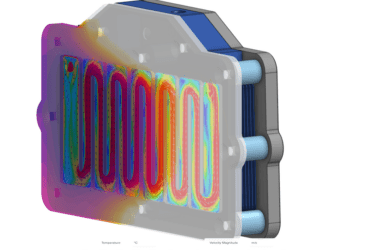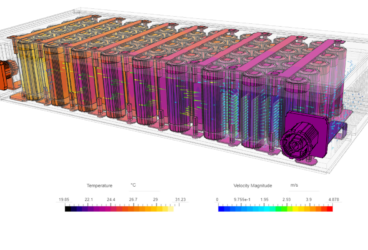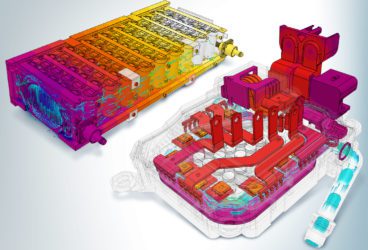Battery technology is an integral part of our lives: from smartphones to massive electrochemical energy storage systems and from hybrid automobiles to fully electric airplanes, our dependence on batteries is ever increasing. This technology, however, is far from perfect, and optimizing battery design—particularly in terms of thermal management and heat transfer—is a key challenge for engineers and manufacturers today.
While lithium-ion batteries are the best rechargeable batteries available today, they suffer from two major disadvantages: (1) they degrade, albeit slowly, and (2) they are quite sensitive to heat. In this article we will focus on the second aspect—more specifically, we will address the use of numerical simulations in understanding thermal management and heat transfer in battery technology. Though much of the following discussion concerns the battery packs used in electric vehicles, it is applicable to any technology that utilizes lithium-ion technology.
The performance and life of a battery is, among other things, affected by the battery design, the materials used, and the operating temperature. For battery packs used in electric or hybrid vehicles, the operating temperature (usually in the range of 20 °C – 35 °C) is critical to maximizing its efficiency. Operating at lower temperatures affects capacity, while higher temperatures deteriorate lifespan. Reports indicate that electric vehicles’ mileage could decline by as much as 60% when the ambient temperature drops below −6 °C and roughly 50% when operated at 45 °C. Another factor that affects the lifespan of battery packs is internal temperature distribution. A difference of more than roughly 5 °C in a cell / module (many of which can be inside a pack) reduces the overall lifespan as well as capacity. Fig. 01, shows the temperature distribution in a standard battery rack.
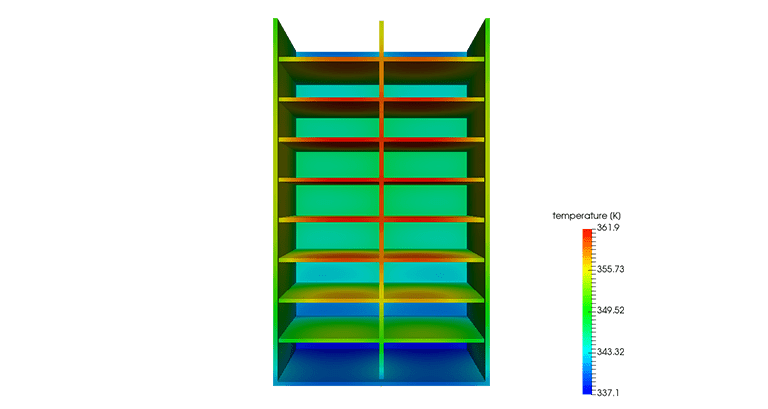
As illustrated, temperatures can, in normal circumstances, range between 25 °C to 35 °C. Without question, the thermal behavior of batteries in realistic operating conditions has a strong influence on their utility across applications, hence, maintaining an efficient and accurate thermal management is of paramount importance.
Overview of the Simulation-Based Approach
Numerical simulations of thermal management systems have proven to be an excellent way to develop and improve battery design at a significantly lower cost than physical testing. A well-defined and designed simulation approach can help predict thermal physics inside a battery accurately, and therefore, can act as a useful tool during the early stages of the design process.
Many different simulation models have been used to evaluate the thermal performance of a battery cell—from simple lumped capacitance models on one end of the spectrum to full-blown 3D simulation models on the other. However, all of these models are constructed using the same basic pieces of the fundamental energy balance equation: (a) What are the sources of heat generation? (b) What are the geometric and thermal properties of the battery cells? And, finally, (c) What cooling mechanism is in place? Different models account for these components to varying degrees of fidelity to suit the desired accuracy and cost considerations.
Heat is generated from two sources:
- Electrochemical operation, which relates to the heat generated due to chemical reactions inside the battery.
- Joule heating, also known as Ohmic heating or the heat generated due to flow of electricity.
Both of these sources need to be considered through their own governing equations. Each one depends on the material properties, local temperature and, of course, the applicable geometry. It is however common practice to use experimentally validated model equations for both of these aspects in order to save significantly on some computations, as well as to simplify the simulation framework.
The geometry of the battery cells and the overall pack could also play a potentially important role in the heat transfer characteristics of the system. It is becoming increasingly common to use full 3D geometries (provided as CAD models) as inputs in the analysis rather than a relatively simplified 2D approximation. The material properties of the different components are obtained from the manufacturer’s data or from other experimental studies.
Lastly, convection is typically the main method for heat dissipation (radiation plays a minimal role, if at all) to the ambience. Conduction heat transfer within the battery may or may not be considered, depending on the desired fidelity of the simulations.
Learn the three basic heat transfer mechanisms in our Thermal Analysis Workshop. Watch our thermal simulation now!
Putting It All Together
Perhaps the simplest approach is the use of a lumped capacitance model. This is a transient conduction approach that assumes the temperature of a solid is spatially uniform and is a function of time only. Without going too far into the details, it is not hard to see that these approaches lack significant detail. Nevertheless, there are instances when these models, if carefully implemented, can present fairly accurate transient data at very low costs.
On the other hand, detailed thermal simulations (such as those provided by SimScale) can provide a more holistic overview of the thermodynamics involved, considering fluid flow and heat transfer within a battery module or pack. In doing so, making it possible to design better battery cooling systems. These simulations have the ability to use exact specifications of the material properties, geometric details, and initial and boundary conditions. If everything is set up effectively, highly accurate results can be expected. CFD techniques have been applied to thermal analysis with great success. Cloud-based simulation tools allow overall computational costs to be considerably reduced, while presenting detailed spatial and transient data. This can be invaluable in establishing a fundamentally sound understanding of the thermal physics involved.
Battery Design Simulation with CFD
An example of successful CFD battery simulation can be found in the work of Yi, Koo & Shin in their paper “Three-Dimensional Modeling of the Thermal Behavior of a Lithium-Ion Battery Module for Hybrid Electric Vehicle Applications” published in the Journal “Energies”. The Li-ion battery module was set up as shown in Fig. 02.

The resulting temperature distribution within the module after 1620 seconds of discharge and heat transfer is as shown in Fig. 03.
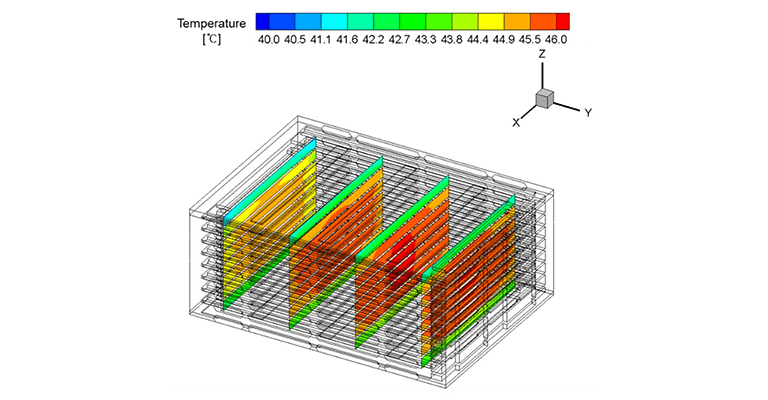
Conclusions
The multiphysics nature of this problem means that in each of these approaches, simplifications have been made to several aspects. Therefore, there is always room for improvement. The list below shows just a selection of these challenging aspects:
- More accurate modeling of the battery chemistry and charge/discharge cycles;
- Batteries that consist of a wide range of materials, including thin layers of metals (encasing the cells), porous materials, etc;
- If several layers of different materials are used within the battery design, internal material can be anisotropic in nature;
- If the material properties of the battery design are generally not very well known, this can significantly affect simulation accuracy; and
- Modeling cooling fluid flow is always a challenge due to complex geometry and possible fluid turbulence involved.
Increasing computational power has allowed researchers to account for more of these aspects accurately and efficiently. Improving our confidence in the predictive capability of such simulations. In spite of the remaining challenges, numerical simulations have contributed tremendously to the design of better thermal management systems for battery design and will continue to do so in the foreseeable future!
Check out all of our SimScale blogs here for more helpful articles!


